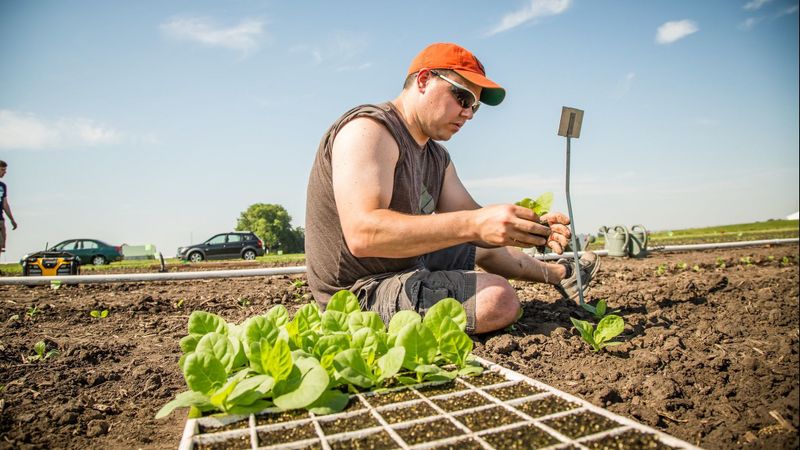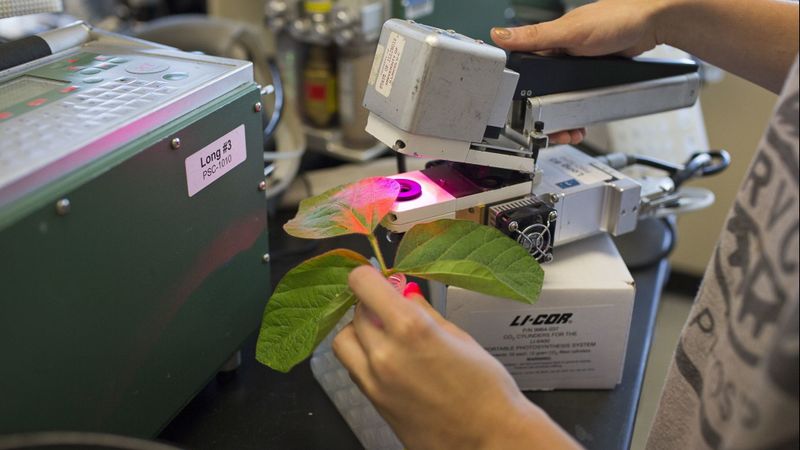Scientists improve on photosynthesis by genetically engineering plants
Ever since Thomas Malthus issued his dire prediction in 1789 that population growth would always exceed food supply, scientists have worked to prove him wrong. So far, they’ve helped farmers to keep pace by developing bigger and better varieties of crops and other agricultural innovations.
Now researchers are taking an even more audacious step: reprogramming plants to make photosynthesis more efficient. And it seems to be paying off.
Tobacco plants that were genetically engineered to optimize photosynthesis outgrew their conventional relatives by up to 40%, according to a study in Friday’s edition of the journal Science.
“It’s beautiful, really, in its elegance,” said Christine Foyer, a plant biologist at the University of Leeds in England who was not involved in the work.
Scientists have homed in on photosynthesis because it offers one of the few remaining options for drastically boosting crop yields. Plant breeders have already selected for vigorous varieties that produce more of whatever we want to eat — be it leaves, fruit, roots or seeds — when grown under ideal conditions.
“We really need to be able to manipulate photosynthesis, because it’s really all that’s left,” said plant biologist Don Ort of the University of Illinois at Urbana-Champaign, the study’s senior author.

Fortunately, there’s plenty of room for improvement — theoretically, at least.
Despite its ability to build towering redwoods and vast coral reefs, photosynthesis is a fairly inefficient process. Only a tiny fraction of available light gets used to produce sugars and other carbohydrates.
“The photosynthetic system has evolved to be very flexible, rather than fully optimal,” Foyer said. “There was a compromise.”
Part of the problem is that plants spend a lot of energy compensating for a bug in their operating system.
It involves an enzyme called RuBisCO whose job is to grab carbon dioxide molecules and send them down the assembly line.
The process worked great when photosynthesis first evolved billions of years ago because there was no oxygen in the atmosphere. But once it built up — thanks, of course, to photosynthetic plankton — RuBisCO began latching on to the wrong gas by accident.
The resulting compound was not just useless, but toxic. So plants had to find a way to convert it into something safe and functional.
Unfortunately, Ort said, “the way that plants picked to do turned out to be both very complex and very energy-intensive.”
Their solution involves shuttling the undesirable molecule outside the chloroplast, where photosynthesis occurs, and into another organelle called a peroxisome. From there, it goes into the mitochondria before retracing its path to the chloroplast in a more tolerable state.
This cumbersome process, known as photorespiration, eats up some of the energy the plant has already stored as sugar and reduces crop yields by 20% to 50%.
“That fixing of oxygen is really like anti-photosynthesis,” Ort said.
So his team decided to update the photorespiration algorithm.
They took tobacco plants — which are easy to work with — and inserted new genes into their DNA that created a shortcut for processing the unwanted compound. They tried three alternatives, two of which had been developed by other scientists. The researchers also silenced a gene to keep the molecule from leaving the chloroplast in the first place.
“It’s really a very, very complex piece of engineering,” Foyer said.
The modification worked wonders. In greenhouse experiments, the engineered plants put on almost 25% more biomass than their unaltered counterparts. Field trials — the gold standard for testing new crops — had even better results, with some plants outproducing their relatives by 40%.
“Some of that, we think, was due to compound interest,” Ort said. Young plants grew faster and increased their leaf area, which allowed them to photosynthesize even more.

The researchers have started making the same changes in food crops such as soybeans, cowpeas and potatoes.
“There’s no reason to suspect that you wouldn’t have a similar result,” Foyer said.
However, it won’t work on crops such as corn and sugarcane, which have a different way of fixing carbon.
Ort’s team is also collaborating with another group at the University of Illinois that engineered tobacco plants to utilize more light, resulting in a 15% increase in productivity.
“We’re now in the process of what we call stacking those two traits,” Ort said. Models suggest that the benefits will add up, boosting productivity by more than 50%. But, Ort cautioned, “until you do the experiments, you don’t know.”
Both efforts are the fruit of the RIPE project, which stands for Realizing Increased Photosynthetic Efficiency. Its motivation is simple: to increase crop yields and combat food insecurity. (The $70-million initiative has gotten much of its funding from the Bill and Melinda Gates Foundation, which requires that any crops developed through the program be made accessible to farmers around the world).
Today, growers still manage to squeeze more food out of every acre of land by using more productive crops and supplying them with plenty of nutrients and water. But gains have slowed to just 1% to 2% per year, and some scientists expect the trend could reverse as a result of climate change.
That will make it difficult to tackle the challenges facing humanity in the coming decades: growing enough food to feed an estimated 9.7 billion people by 2050, and doing so without destroying the planet. While the first Green Revolution succeeded in dramatically increasing food production, it also brought a host of environmental problems, including increased use of fertilizer and pesticides, water pollution, soil degradation, and erosion.
“It really isn’t possible to continue the way that we are going,” Foyer said.
In the future, scientists say, we must find ways to produce more food on the same amount of land and using fewer resources. One solution is to ensure plants make the most of what they have, as Ort’s team has done with their tobacco plants, Foyer said: “That’s why this is important.”
The new results are a great start, said Heike Sederoff, a plant biologist at North Carolina State University in Raleigh. But she said researchers will still have to assess whether the new photosynthetic trait persists across generations and whether it makes plants more or less susceptible to environmental stressors such as drought.
“Those things are all stuff that needs to be tested,” she said.
Genetically modified crops also remain controversial, especially in Europe and Africa, where many countries have banned them, Sederoff noted. So the potential of these crops will depend partly on how attitudes and regulations evolve.
But Ort said the clock is ticking. It takes 12 to 15 years for a new crop to go from the lab to farmers’ fields, which means that if his team or others do manage to develop more efficient varieties, they won’t be on our plates until the mid-2030s.
By the middle of the century, food production will have to increase by 25% to 70% to meet demand, according to one recent estimate.
“There really is some urgency,” Ort said.
By: Julia Rosen | Los Angeles Times
RELATED RIPE OBJECTIVES
Photorespiratory Bypass